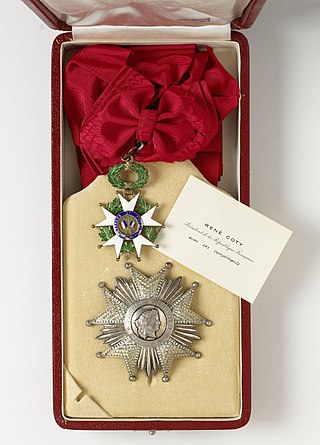
The National Order of the Legion of Honour, formerly the Royal Order of the Legion of Honour, is the highest French order of merit, both military and civil. Established in 1802 by Napoleon Bonaparte, it has been retained by all later French governments and regimes.

The Order of Leopold is one of the three current Belgian national honorary orders of knighthood. It is the oldest and highest order of Belgium and is named in honour of its founder, King Leopold I. It consists of a military, a maritime and a civil division. The maritime division is only awarded to personnel of the merchant navy, and the military division to military personnel. The decoration was established on 11 July 1832 and is awarded by Royal order.
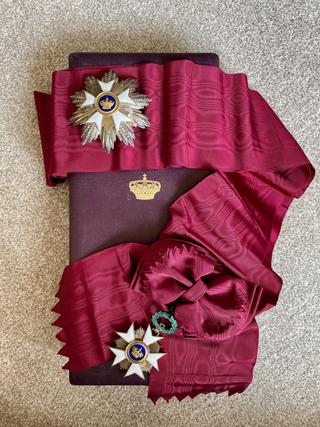
The Order of the Crown is a national order of the Kingdom of Belgium. The Order is one of Belgium's highest honors.

The Order of Orange-Nassau is a civil and military Dutch order of chivalry founded on 4 April 1892 by the queen regent, Emma of the Netherlands.

The Order of Civil and Military Merit of Adolph of Nassau is an order of merit of the Grand Duchy of Luxembourg for meritorious service to the Grand Duke, the Grand-Ducal House and Luxembourg. It was founded in 1858 as a chivalric order of the Duchy of Nassau by Adolphe of Nassau in honor of his namesake and ancestor, Adolf, Count of Nassau, the only member of the House of Nassau to have been Roman King of Germany. After the Duchy of Nassau was annexed by Prussia in 1866 and Adolphe became Grand Duke of Luxembourg in 1890, he revived the order as an order of merit.
The Order of Leopold II is an order of Belgium and is named in honor of King Leopold II. The decoration was established on 24 August 1900 by Leopold II as Sovereign of the Congo Free State and was in 1908, upon Congo being handed over to Belgium, incorporated into the Belgian awards system. The order is awarded for meritorious service to the sovereign of Belgium, and as a token of his personal goodwill. It can be awarded to both Belgians and foreigners, and is seen as diplomatic gift of merit.

The Royal Order of the Polar Star, sometimes translated as the Royal Order of the North Star, is a Swedish order of chivalry created by King Frederick I on 23 February 1748, together with the Order of the Sword and the Order of the Seraphim. The Order of the Polar Star is intended as a reward for Swedish and foreign "civic merits, for devotion to duty, for science, literary, learned and useful works and for new and beneficial institutions".
The Order of the African Star was established by Leopold II of Belgium on 30 December 1888, in his capacity as ruler of the Congo Free State, and was awarded for services to Congo and for the "promotion of African civilisation in general". It was incorporated into the Belgian honours system on 10 October 1908 following the annexation of the Congo Free State by Belgium. The motto of the Order is "Travail et progrès". The King of the Belgians is its Grand Master; although the Congo is no longer a Belgian colony, it is still considered to be a Belgian Order by tradition.
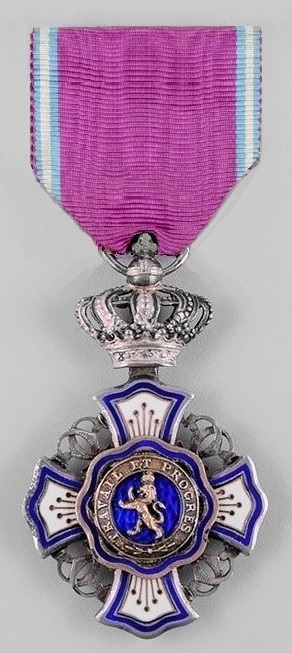
The Royal Order of the Lion was established by King Leopold II of Belgium on 9 April 1891, in his capacity as ruler of the Congo Free State, and was awarded for services to the Congo and its ruler that did not deserve the award of the Order of the African Star, and were not necessarily performed from within Belgian Congo.
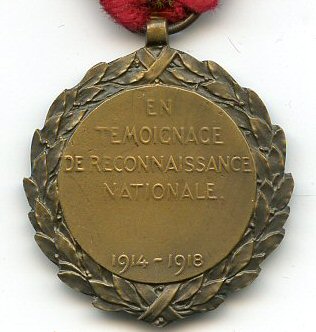
The King Albert Medal was a Belgian medal established by royal decree on 7 April 1919 and awarded to both Belgians and foreigners who were exceptionally meritorious in promoting, organising or administering humanitarian and charitable work that assisted Belgians in need during the First World War.
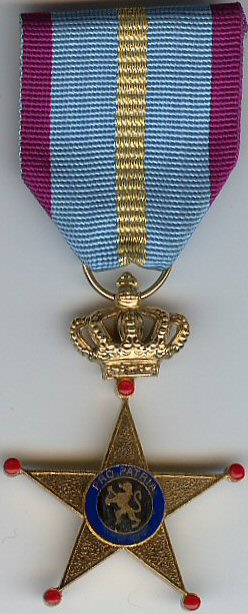
The Cross of Honour for Military Service Abroad is a Belgian military decoration originally established for award to Belgian servicemen who served for a long period of time in the Federal Republic of Germany, Zaire, Rwanda or Burundi. It was established on 16 June 1997 in three classes.
The Civic Decoration is a civilian decoration of the Kingdom of Belgium. It was first established by royal decree on 21 July 1867 to reward exceptional acts of bravery, devotion or humanity. A further royal decree of 15 January 1885 extended the award to state civil servants for long service by a mere change of ribbon. The award statute was once again amended by royal decree in 1902 to include long service in the Civic Guard and firefighters, each with its distinctive ribbon.

The Commemorative Medal for Armed Humanitarian Operations is a military decoration of Belgium. It was established on 11 September 1987 and is awarded to military and civilian members of the Belgian Armed Forces who participated in armed humanitarian operations. Although never explicitly stated, in practice, the medal is only awarded for a select number of operations on African soil.
The Croix de guerre (French) or Oorlogskruis (Dutch) is a military decoration of the Kingdom of Belgium established by royal decree on 25 October 1915. It was primarily awarded for bravery or other military virtue on the battlefield. The award was reestablished on 20 July 1940 by the Belgian government in exile for recognition of bravery and military virtue during World War II. The post-1940 decoration could also be awarded to units that were cited. The decoration was again reestablished by royal decree on 3 April 1954 for award during future conflicts.

The Deportees' Cross 1914–1918 was a Belgian war medal established on 27 November 1922 by royal decree and awarded to Belgian citizens deported to Germany for forced labour during the First World War.

The Political Prisoner's Cross 1940–1945 was a Belgian war medal established by royal decree of the Regent on 13 November 1947 and awarded to Belgian citizens arrested and interned by the Germans as political prisoners during the Second World War. The award's statute included provisions for posthumous award should the intended recipient not survive detention, and the right of the widow, the mother or the father of the deceased to wear the cross.
The Labour Decoration is a Belgian labour long service medal originally established on 7 November 1847 under the name "Industrial and Agricultural Decoration". Its statute and design were reformed in 1958, since when it has retained its present name and design. The Labour Decoration is awarded to those who use their knowledge, talent and dedication in the pursuit of their work for a specified time. It is awarded by the Belgian Ministry of Employment and Labour.

In 1833, following the end of the Belgian Revolution, the young kingdom of Belgium created the Iron Cross to recognise wounds received and bravery in battle. The award first class was bestowed to the wounded who elected to stay at their post and keep fighting, to the maimed and mutilated, as well as for acts of courage, the award second class was bestowed to all wounded combatants. In 1835, due to the discontent of most recipients, the award 2nd class was terminated and all received the first class. Over the years, recipients of the Iron Cross received ever increasing pensions, up to ten years of seniority when employed as civil servants and pensions for the widows and orphans of the deceased. The other combatants of 1830-1831 received no pension, and no commemorative medal was struck.

The Commemorative Decoration of the 50th Anniversary of the Creation of the Railroads 1834-1884 was a Belgian commemorative award denoting the 50th anniversary of the law of 1 May 1834 ordering the creation of railroads in Belgium. It was established by royal decree of King Leopold II on 30 April 1884 at the suggestion of the ministers of Public Works and of the Interior, its statute was ratified by a further royal decree on 11 July 1884.
The Medal of Belgian Gratitude is a Belgian medal instituted to be awarded to civilians on 1 August 1945.















